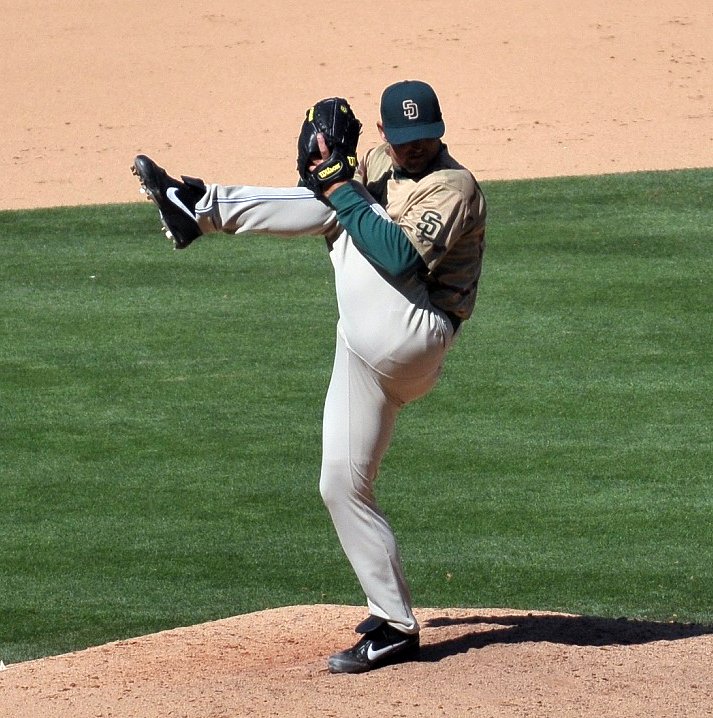In both softball and baseball, a changeup is the one pitch that can literally throw a hitter off stride.
It’s also called the off-speed pitch. Announcers will say the pitcher “pulled the string,” as if the ball had been yanked back and slowed down. A lot of pitchers who have mastered the pitch have become master pitchers. Pitchers know that the changeup can get outs. Hitters know the pitcher will throw it when the hitter is looking for a fastball to hit out of the park.
There are two ways to look at the pitch: from the mound and from the batter’s box.
FROM THE MOUND
Most MLB pitchers have a changeup in their arsenal and mix it up with their fastball. Here’s a look at a few pitchers with a reputation for getting the most out of their off-speed stuff.
The Yankee Killer.
In the ’50s and ’60s, left-handed thrower Johnny Podres used the changeup to help the Brooklyn Dodgers defeat the Yankees in the 1955 World Series. Podres had a great fastball, a good curve and an unusual windup, with his arms and legs flailing wildly, that made his off-speed pitch even more effective. The legendary sportswriter Jim Murray once said, “He squirts the ball out of his tentacles like an octopus.”
Hoff. Trevor Hoffman, the great Padres reliever and best NL reliever of his era, learned how to throw his changeup after an arm injury affected his fastball and caused him to change his style. Hoffman threw his change-of-pace—one of the best—using a “palm ball” approach, stuffing the ball in the back of his hand and closing all his digits around it. One described it by saying, “It’s like it has a parachute on it.” The changeup extended Hoffman’s career, and he used it to be the first pitcher to reach 500 saves, and then 600. He pitched into his forties.
King Felix. Felix Hernandez of the Seattle Mariners is named often as the current player with the best changeup, even though not everyone calls it a changeup. That’s because the pitch doesn’t just come in slower—it dips and moves as well. One player differentiates his changeup from other pitchers’ by describing it as a “Felix Hernandez changeup.” Hernandez didn’t even throw a change for the first five or six years of his career. “In ’05, ’06, ’07 and ’08, I wasn’t throwing any changeups at all. Maybe two or three per game. In ’09, I started playing with the grip, started throwing it in the bullpen and playing catch. It came out really good.”
 FROM THE BATTER’S BOX
FROM THE BATTER’S BOX
Talk to any pitcher—softball or hardball—and they’ll tell you that one of their goals is to keep the hitter guessing and throw off his timing. They do that by mixing their pitches, mixing location and throwing a changeup for strikes.
A good changeup produces groundouts, swinging misses and lots of foolish-looking hitters.
Softball hitting coaches stress how important it is for batters to maintain their balance, keep their hands back and stay patient. Hitters must turn on the ball quickly once they decide to swing, waiting as long as they can to whip the bat around. This approach gives the hitter the best chance to hit a fastball while maintaining the ability to time their swing if the pitch is a changeup.
This is a problem that hitting coaches and all hitters face, whether softball or baseball, younger or older: There’s not always someone there to throw a mix of fastballs and good, over-the-plate changeups to hitters during batting practice.
And since good, consistent swings come only with hundreds of good swings, coaches are often at a loss to teach batters how to handle a good pitcher with a good off-speed pitch.
FROM JUGS® SPORTS: A TEACHING TOOL
A solution to the problem was introduced by JUGS Sports, which manufactures pitching machines used at all levels of the game.
• The new JUGS CHANGEUP Super Softball™ Pitching Machine
• The new JUGS CHANGEUP Baseball Pitching Machine
The Changeup Pitching Machines give coaches a great way to teach hitters how to handle the changeup. Both machines pitch fastballs at up to 70 mph and, with the help of the small remote control, a coach can drop the speed of the next pitch, without the batter being aware. The coach can also change speeds right from a panel on the machine.
Not only do the JUGS Changeup Pitching Machines change speeds on command, but they also throw strikes each time. Now teams can have batting practice with consistent, game-speed fastballs and changeups...with the element of surprise.
Here’s what coaches are saying about the JUGS Changeup Pitching Machines:
“Hitting off the JUGS new Changeup Super Softball machine is the next best thing to live batting practice.” – Hannah Pomeroy, College Softball Player and Coach
“To have the ability to throw two different pitches and now have to work on the timing aspect is something that has always been lacking in pitching machines…until now.” – Scott Brosius, World Series MVP, College Baseball Coach

